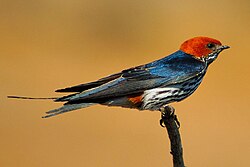| Lesser striped swallow | |
|---|---|
 | |
| In South Africa | |
| Song recorded in the Masai Mara Game Reserve, Kenya | |
| Scientific classification | |
| Kingdom: | Animalia |
| Phylum: | Chordata |
| Class: | Aves |
| Order: | Passeriformes |
| Family: | Hirundinidae |
| Genus: | Cecropis |
| Species: | C. abyssinica |
| Binomial name | |
| Cecropis abyssinica (Guérin-Méneville, 1843) | |
 | |
| approximate range | |
| Synonyms | |
Hirundo abyssinica | |
The lesser striped swallow (Cecropis abyssinica) is a large swallow. It breeds in Sub-Saharan Africa from Sierra Leone and southern Sudan south into eastern South Africa. It is partially migratory with South African birds wintering further north. West African birds leave the north of the breeding range in the dry season.





